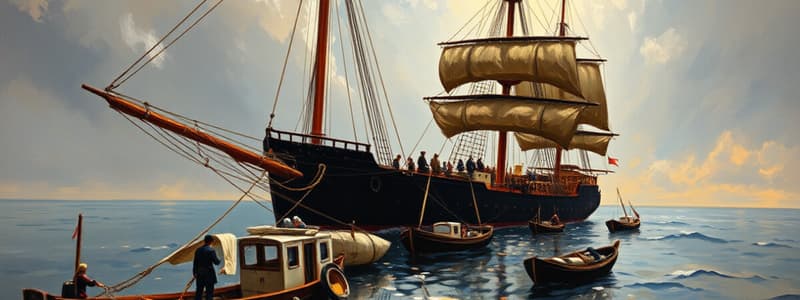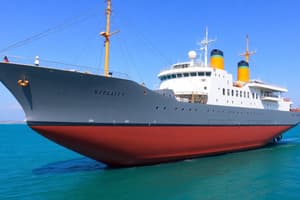Podcast
Questions and Answers
What defines the center of gravity (CG) in a floating object?
What defines the center of gravity (CG) in a floating object?
- The point where the object's entire weight is considered concentrated (correct)
- The point that determines the buoyancy of the object
- The centroid of the submerged volume
- The point where all external forces are applied
Which term describes the permanent tilting of a ship due to uneven weight distribution?
Which term describes the permanent tilting of a ship due to uneven weight distribution?
- Righting Moment
- Stable Equilibrium
- Heeling
- Listing (correct)
What is the role of the metacenter (M) in ship stability?
What is the role of the metacenter (M) in ship stability?
- It refers to the distance between the CG and the CB
- It determines the weight displacement of the ship
- It indicates a ship's initial point of heeling
- It is the point of intersection of vertical lines through successive CB positions (correct)
What is a characteristic of stable equilibrium in a ship?
What is a characteristic of stable equilibrium in a ship?
Which of the following is true regarding loaded displacement?
Which of the following is true regarding loaded displacement?
How does density affect buoyancy in fresh and seawater?
How does density affect buoyancy in fresh and seawater?
What does the term 'deadweight' refer to on a ship?
What does the term 'deadweight' refer to on a ship?
What describes the vertical center of gravity (CG) in relation to a ship's stability?
What describes the vertical center of gravity (CG) in relation to a ship's stability?
Flashcards are hidden until you start studying
Study Notes
Stability Terminologies
- Stability: The capacity of a ship to resist capsizing under external forces.
- Center of Gravity (CG): The single point where the weight of an object is uniformly distributed.
- Center of Buoyancy (CB): The centroid of the submerged volume; the point through which buoyant force acts.
- Vertical CG: CG's position relative to the waterline; affects stability.
- Longitudinal CG: CG's position from the front to the back of the ship.
- Transverse CG: CG's position from one side of the ship to the other.
- Heeling: The tilting motion of a ship caused by external forces, such as wind or waves.
- Listing: A permanent tilt resulting from uneven weight distribution onboard.
- Stability Moment/Righting Moment: The force that assists a heeled ship in returning to a vertical position.
- Stable Equilibrium: Condition where the ship naturally returns to an upright position after tilting.
- Neutral Equilibrium: Condition where the ship retains its position after tilting without returning to upright.
- Unstable Equilibrium: Condition where the ship continues to tilt away from its original position once disturbed.
- Righting Lever (GZ): The distance between CG and CB when the ship is heeled, crucial for calculating stability.
- Metacenter (M): The point where vertical lines intersect through successive positions of CB, essential for determining the stability of a floating vessel.
- Weight Displacement: The equivalent weight of water that is displaced by a floating object, indicating buoyancy.
- Density of Fresh Water (FW): Mass of one unit volume, used as a reference for specific gravity measurements.
- Density of Sea Water (SW): Mass of one unit volume of seawater, typically higher than that of fresh water.
- Specific Gravity of FW: Ratio comparing the density of a substance to that of fresh water.
- Specific Gravity of SW: Ratio comparing the density of a substance to that of seawater.
- Lightship: A vessel with no cargo, fuel, or passengers aboard; its baseline weight.
- Loaded Displacement: The total weight of the ship when loaded, including cargo and provisions.
- Deadweight: The maximum weight that a ship can safely carry, including cargo, fuel, water, and provisions.
- Payload: Weight accounted for by passengers and cargo the ship is transporting.
- Gross Tonnage: The total internal volume of a ship, a measure of its carrying capacity.
- Net Tonnage: The volume of cargo space available on the ship for cargo transportation.
Studying That Suits You
Use AI to generate personalized quizzes and flashcards to suit your learning preferences.




